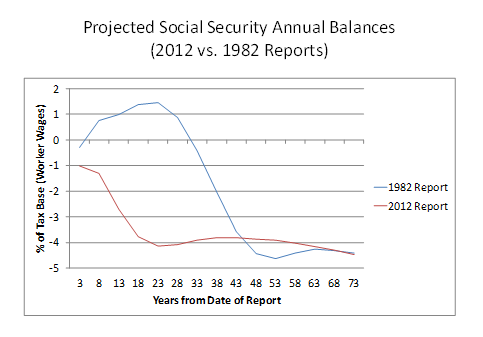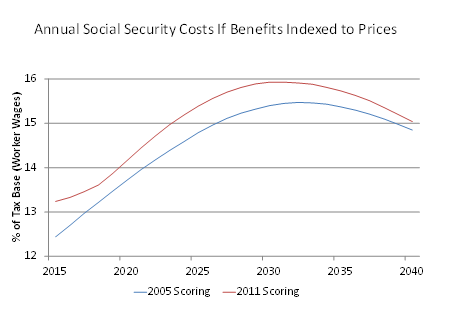- | Government Spending Government Spending
- | Expert Commentary Expert Commentary
- |
Is It Becoming Too Late to Fix Social Security's Finances?
Those who care about the Social Security program need to clearly understand the consequence of this ongoing neglect; that time for a realistic financing solution has nearly run out.
One of my duties as a public Social Security trustee is to explain the program’s financial condition, both formally as a signer of the annual Board report, and less formally in published summaries, articles,interviews and Congressional testimony. This evaluation is written pursuant to that responsibility.
Social Security’s future, at least in the form it has existed dating back to FDR, is now greatly imperiled. The last few years of legislative neglect -- due to a failure of national policy leadership coming just as the baby boomers have begun to retire -- have drastically harmed the program’s future financial prospects. Individuals now planning their financial futures, whether as taxpayers or as beneficiaries, should be pricing in a substantial risk that the federal government will not be able to maintain Social Security as a self-financing, stand-alone program over the long term. If Social Security financing corrections are not enacted in 2013, or at the very latest by 2015, it becomes fairly likely that they will not be enacted at all.
Below I will first explain how the Social Security shortfall is usually described and approached. Then I will explain why Social Security’s financial prospects are much grimmer than is commonly understood. Finally I will explain why this matters, i.e. – the likely consequences if the President and Congress continue to fail to balance its books.
Common Measures of the Social Security Shortfall: Social Security’s long-term financing shortfall is now estimated at 2.67% of the program’s tax base (worker wages). Insolvency of the program’s combined trust funds is now projected for 2033 (2016 for its disability program). Figures such as 2033 and 2.67% make it appear – incorrectly – as though there are several years remaining to act, and only a modest problem to solve.
Multiple Solutions: There is no shortage of Social Security reform proposals that would, at least on paper, successfully shore up program finances. I personally have put forward some, and the Social Security Actuary has scored several others. Proposals from the right tend to focus on cost containment (e.g., slowing the growth of benefits and/or raising eligibility ages), whereas proposals from the left tend to focus on raising taxes. As I explain below, this multitude of proposals in no way implies that a solution is readily achieved.
Why a Solution is Rapidly Becoming More Difficult: There are several reasons.
- The baby boomers are starting to retire. Lawmakers have historically been very reluctant to cut benefits for beneficiaries once they start receiving them. This means that any sacrifices will likely be concentrated on younger generations who already facenet income losses through Social Security as it is. With every further year of delay lawmakers must therefore consider sharper benefit growth reductions and/or tax increases.
- A solution requires substantial compromise by one or both sides. If one person (or a unified political party) commanded total political power and was willing to use it, they could impose their preferred solution on those who disagree. The last such opportunity was probably 2009-10 when Democrats controlled both chambers of Congress and the White House. Had they so chosen, they could have shored up Social Security on their own terms. No such attempt was made. Today no one expects that either party will single-handedly control the White House, the House, and 60 votes in the Senate within the next few years. Thus if Social Security finances are to be repaired, someone must dramatically compromise: either progressives must accept substantial benefit growth reductions, conservatives substantial tax increases, or both. Unfortunately as I will show below, we are already long past the point where there is precedent for a compromise of this magnitude.
- There is a huge disparity between the problem’s urgency and the rhetoric applied to it by substantial factions of the body politic. Even as time is running out for a workable compromise, some continue to play a high-stakes gamble: that if theurgency is downplayed and action delayed past the next few elections, it can be dealt with when the political alignment may be more advantageous to one side. This gambit has now been extended to the point of imperiling Social Security’s long-term outlook. Too many key players, however, do not yet realize this.
No Bipartisan Grand Bargain Has Ever Eliminated a Social Security Shortfall This Large: The historical high-water mark for a comprehensive bipartisan rescue was the 1983 Social Security amendments. The program was then saved from the brink of insolvency. Benefit checks had literally been just months away from being interrupted. Both sides agreed on the urgency and immediacy of the crisis, yet very nearly failed to reach agreement.
The program’s long-term shortfall in 1982 was measured as 1.82% of the program’s tax base. Today it’s measured as 2.67% -- much larger even on the surface. Yet many don’t realize that the trustees’ methodologies were changed in 1988 to make the shortfall appear smaller. If we still measured as was done in 1983, today’s shortfall would be 3.5% of the tax base -- nearly twice as large as the 1983 gap.
The graph below compares current projections with those made at the time of the 1982-83 crisis, specifically for the 75-year period immediately following each report.
The graph shows projected differences between annual “non-interest” income (payroll taxes, benefit taxes and any general revenues) and the cost of paying benefits, in relation to the program’s tax base. Points above the zero line indicate an annual surplus; points below indicate an annual deficit. Because in 1982 long-term projections were only specified for years that were multiples of 5 (2015, 2020, etc.), I mark the estimates at spans of 3, 8, 13, etc., years from the dates of the respective reports.

It’s immediately visually apparent that today’s long-term problem is not only worse than in 1982-83, but much worse. Shortfalls over the long term equal roughly 4% of the program’s tax base in either case. The big difference is in the near term; we’re now 20 years closer to deficits of that magnitude than they were then, and must effectuate large corrections much more rapidly.
In the early 1980s they merely had to get through a relatively small near-term solvency crisis before entering decades of previously-projected surpluses as the baby boomers moved through the workforce. The 1983 reforms could thus be much gentler than those required today.
Yet even the 1983 adjustments were nearly more than the political system could bear. Lawmakers had to delay COLAs by six months; bring federal employees (and their payroll taxes) into the program; expose beneficiaries to new benefit taxation, among other measures. These were intensely controversial and pushed the limits of political salability – yet were far less than a solution today requires.
A solution enacted today would require left and right to cede roughly twice as much ground as they did in the 1983 reforms, or one side must cede still more. Each year that passes, influential players must retreat still further from their preferred policies. At some point (which we may well be past already), one side, the other, or both will reach the limit of how much they are willing to swallow.
The fate of the Simpson-Bowles Social Security proposal exemplifies how difficult forging a compromise has become. That proposal, developed by the bipartisan co-chairs of President Obama’s Fiscal Responsibility Commission, was Solomonically divided almost 50/50 between revenues and cost constraints (46/54, exactly). The Obama White House distanced itself from the proposal after it was repeatedly attacked by many of the President’s political allies. It failed to receive the requisite support on the commission, with defections on both the Republican and Democratic sides. Such political heat is only going to grow more intense: due to subsequent deterioration in system finances, the next solution debated will need to impose even tighter financing constraints than Simpson-Bowles proposed.
Some of the Toughest Solutions Proposed Already No Longer Work: As another illustration of the growing difficulty of solution, let’s look at the competing approaches of containing cost growth and raising taxes. One longstanding proposal has been to slow future benefit growth to the rate of price inflation for high earners, while allowing low-income earners the higher growth rate of wage inflation, and leaving previous beneficiaries unaffected. But already now, even if we slowed everyone’s benefit growth – from the poorest to the richest – to price inflation, we could no longer maintain solvency while holding harmless those over the age of 55. See the graph below.

The graph shows how six years of delay have increased the cost of this particular approach. Had across-the-board price-indexing been enacted in 2005, it could have kept Social Security fully solvent, left those over 55 untouched, and generated additional funds to provide for faster benefit growth on the low-income end. Enacted last year, however, such across-the-board price-indexing would no longer be enough; costs would be substantially higher and the trust funds would be depleted in 2040 unless further measures were taken. And if re-scored under 2012 assumptions, this proposal would fare still worse.
The efficacy of tax-increase solutions is also fading with delay. Advocates on the left sometimes argue to increase the amount of Social Security wages subject to the payroll tax. The most extreme version of this proposal would be to raise the amount of wages subject to the full 12.4% payroll tax -- $110,100 today – up to infinity. Yet even this drastic measure would now fail to keep Social Security in long-term balance as well.
We are thus approaching the point where each side would have difficulty balancing Social Security finances even if it could dictate the solution -- and rapidly passing the point where a compromise solution remains reasonably likely. What does this mean for Social Security’s future?
Toward a Very Different Social Security Program: If a financing solution cannot be reached, then Social Security’s self-financing construct would need to be abandoned. Assuming the program continues to pay benefits, it would have to permanently rely on subsidies from the general fund as Medicare now does. This would be a valid policy choice, but it carries unavoidable consequences. It would mean an end to one of the program’s foundational principles: the requirement that Social Security pay its own way through a separate trust fund. It would also mean an end to FDR’s conception of an “earned benefit” program in which workers were seen to have paid for their own benefits.
Upon merging into the general fund, Social Security benefits would be far less secure going forward. Benefit payments would have to compete with other annual spending priorities, and would be limited to those deemed affordable given pressures elsewhere in the budget. They would thus be much more susceptible to sudden reductions, means-tests, and other episodic changes to which general fund financed programs have long been subjected.
If this all happens, and renders tomorrow’s Social Security benefits less secure than today’s, it would be a tragic irony: the outcome would have been brought about largely by supporters of Social Security having countenanced the tactics of delay to the point that the program’s unique political protections could no longer be preserved. Those who care about the Social Security program need to clearly understand the consequence of this ongoing neglect; that time for a realistic financing solution has nearly run out.